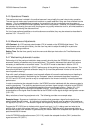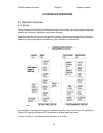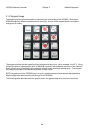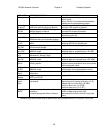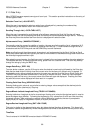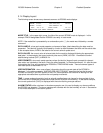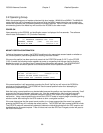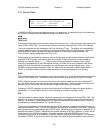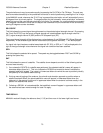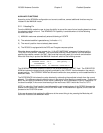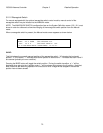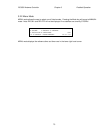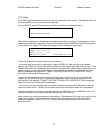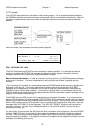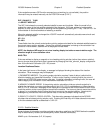RC3000 Antenna Controller Chapter 3 Detailed Operation
70
The polarization axis may be moved manually be pressing the Pol CCW or Pol CW keys. The axis may
also be moved automatically to the predefined horizontal or vertical positions by pressing the H or V keys.
In the MANUAL mode, whenever the “5 H/V” key is pressed the polarization axis will automatically move
90 degrees from its current position. The target position for this automatic “cross polarization” movement
takes into account the user defined polarization axis limits. For example, if a cross polarization movement
of 90 degrees clockwise will move the axis beyond the clockwise limit, the movement will be achieved by
moving 90 degrees counter-clockwise.
SS1/SS2/RF:
This field shows the current signal strength sensed on the selected signal strength channel. By pressing
the “Scroll Dn RF/SS” key the source of signal strength will rotate between signal strength channel 1
(SS1), signal strength channel 2 (SS2) and the RF autopeak input (RF).
The current signal strength will be displayed as a value between 0 and 999 (see 2.5.3 Signal Strength
Adjustment). If the selected signal source is saturated (value greater than 999), *** will be displayed.
If a signal lock input has been enabled associated with RF, SS1 or SS2, an “L” will be displayed to the
right of the signal strength value whenever the signal lock condition has been satisfied.
SPD:
This field shows the selected drive speed. The speed may be toggled between FAST and SLOW by
pressing the Speed key.
SAT:
This field shows the name of a satellite. The satellite shown depends on which of the following actions
occurred most recently:
1) if an automatic LOCATE of a satellite was performed, the selected satellite’s name will appear in
lowercase letters (brasil a1). This is to indicate the RC3000 has moved to where it believes the
selected satellite is located. The name is in lowercase letters to remind the user to positively identify
and peak up on the satellite before storing.
2) If during manual jogging of the antenna, the azimuth and elevation approach a position where a
satellite has been stored, the stored satellite’s name will appear in lowercase letters when the
antenna is in the general vicinity and in uppercase letters when the antenna is almost exactly in the
position the satellite was stored.
3) Following a RECALL of a stored satellite, that satellite’s name will appear in uppercase letters until
the antenna has been moved enough for case 2 to apply.
TIME DISPLAY
MANUAL mode will display the reference time (1.3.5) and time zone in the lower right hand corner.



